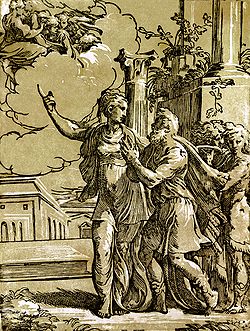Antonio da Trento
Appearance

Antonio da Trento (1508–1550) was an Italian engraver.
Da Trento was born in Trento. He specialized in chiaroscuro woodcuts, especially of religious themes and scenes.[1] Da Trento probably first learned wood engraving from Ugo da Carpi.[2] He later was a disciple of Parmigianino, and later within the School of Fontainebleau.[3]
Da Trento's technique involved creating three separate blocks for each print. The first was for the outlines, the second for shadows, and the third was for the lighter tints. Three documented works of his are The Beheading of St. Peter and St. Paul, The Tiburtine Sibyl showing the Virgin Mary, with the Infant Christ, and Psyche Saluted by the People with the Honors of Divinity.[2]
References
- ^ "Brief Bio Antonio da Trento". Retrieved 2010-03-30.
- ^ a b Strutt, Joseph (1786). A Biographical Dictionary; Containing an Historical Account of All the Engravers, From the Earliest Period of their Art to the Present Time] [etc.], Strutt, Joseph (1786), J. Davis, for Robert Faulder, London. Volume II, p. 367. Retrieved 2010-03-30.
- ^ "Style and Manner of Antonio da Trento". Archived from the original on 2007-10-19. Retrieved 2009-11-16.
Wikimedia Commons has media related to Antonio da Trento.
